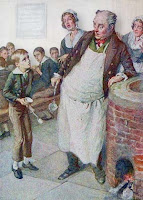Overtaken By Events
Despite Tuesday's updated CDC guidance, this PSA from the California state health department continued to appear on Facebook yesterday. Although the CDC distinguishes between the vaxxed and unvaxxed, clearly this is unenforceable on a sidewalk or transit platform or in a public park. As a practical matter, unless an indoor restaurant strictly enforces the mask rule -- though they'd also have to ask for evidence of vaccination if they did -- masks have basically become optional.
And it's worth noting that it was only on March 30, a mere month ago, that Dr Walensky, the head honcho of the entire US public health establishment, gave her weepy warning of impending COVID doom. Some Cassandra.
But there are lurking questions that, so far, nobody seems to be asking, much less answering. California completely avoided the February-March third surge in COVID cases that was limited mainly to the US northeast. But vaccine became available to all states, with equally limited distribution, in mid-December. California experienced just as many of the new varieties as any other state, and it had just as much travel in and out (but Arizona's and Nevada's COVID patterns are similar to California's). And so far, the vaccines have proven effective against the new varieties.
Yet California is in fact heading toward that word nobody is daring to use, "herd immunity". As of yesterday, 39% of those in the state are "fully vaccinated', at least two weeks past their last shot. LA County has announced that, after three weeks in the "orange" tier, it will almost certainly qualify to move to the still less restrictive "yellow" tier by the middle of next week. The recent trend suggests that the rest of the state will follow within weeks.
The received wisdom from the Mayo Clinic, which reflects the view of the public health establishment, is this:
Experts estimate that in the U.S., 70% of the population — more than 200 million people — would have to recover from COVID-19 to halt the pandemic. This number of infections could lead to serious complications and millions of deaths, especially among older people and those who have existing health conditions. The health care system could quickly become overwhelmed.
. . . But reaching herd immunity through vaccination against COVID-19 might be difficult for many reasons.
The U.S. is currently making progress toward herd immunity through a combined approach.
. . . Given the challenges, it’s not clear if or when the U.S. will achieve herd immunity.
The example of California suggests that the process can take place much faster, and with far fewer vaccinations, than the public health establishment has anticipated. In fact, the pause in the Johnson & Johnson vaccine looks to have been done mostly to try to slow things down, since after dithering for a week and a half, the experts just said "never mind".The question has been raised in many venues why the US Congress, which is assumed to have been fully vaccinated for months, chose nevertheless to be masked and socially distanced for President Biden's address, when even CDC guidelines now suggest this was unnecessary. The answer is that the people who run the planet are clearly reluctant to drop the controls that, however ineffective at stopping multiple surges of COVID, have nevertheless apparently served whatever obscure purpose they've been serving.
What a shame that the public panic is going to go away, later if not sooner. The problem is the people we pay to protect the public health are the ones who'll be least likely to recognize this.
























